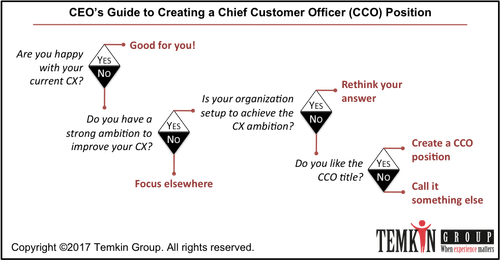Someone recently raised the question: Why do companies need a chief customer officer… isn’t that the job of the CEO?
Versions of that question have been around since the role started to become popular more than five years ago. It’s a fair question, since organizations can’t just keep adding new “Chief <Fill In The Blank> Officers” to their executive teams.
It turns out that the answer is not a simple “yes” or “no.” Here’s a decision tree that a CEO can use to decide if they should create a CCO role:

My view on this question is the same as it has been for many years, the position makes sense in the right environment. Rather than creating something new, I’m sharing a post from 2012 that still holds true: Timeless Advice About Chief Customer Officers…
It seems like there’s been a pickup of interest in the title of “Chief Customer Officer.” I’ve “studied” this role for a while and have worked with dozens of these execs (they often have a different “title”). Here’s my advice for companies that are considering this role that I published in the post: Chief Customer Officer: To Do, Or Not To Do?
There’s a question that I’ve heard a lot that seems to stir up some debate: Do firms need a Chief Customer Officer? Well, I’ve run into zealots on both sides of the argument.
Those who say “absolutely yes” are convinced that companies can’t change without a senior executive who “owns” customer relationships, someone who can bring senior executive visibility to all of a company’s customer-facing efforts. The argument is compelling — customers are certainly important enough to deserve a dedicated executive.
Those that say “absolutely not” are convinced that companies can’t just fix the problem by creating a new executive position. They believe that this ends up being a superficial move — like putting lipstick on a pig. The argument is compelling — people often call for a new executive whenever they don’t know what else to do.
It’s an interesting dilemma when both sides of an argument are compelling. My position on this question is equally dogmatic: Absolutely yes and absolutely no.
To understand my position, let’s start by shifting the question a bit. Instead of asking whether or not you need a person with the specific title of “Chief Customer Officer” let’s ask whether or not you need an executive in charge of a concerted effort to improve customer experience across the enterprise. If a company is truly committed to improving their customer experience, then an executive in charge of that change process will be very important. That person (who may or may not be called “Chief Customer Officer”) can lead a host of efforts like the establishing customer experience metrics and developing of a voice of the customer program.
But this type of position only makes sense if the CEO is truly committed to a significant change and will hold the entire executive team (not just the new executive) accountable for results. If the plan is to make the new executive responsible for “owning” the customer experience, then don’t create this position — it will only provide a handy scapegoat for executives who don’t make the required changes in their organizations.
While we’re on the topic of leading customer experience change, I’ll also touch on another post: Corporate Customer Experience Groups: To Do Or Not To Do? Here’s what I discussed in that post:
Transformation isn’t easy. There’s a very strong need for a centralized group when companies are in a transformational mode, making changes that cut across the entire organization. This type of effort can’t be done without centralized support and facilitation. But companies that invest in centralized groups before the organization is committed to the journey are likely to either 1) completely offload responsibility for customer experience to these groups; or 2) stifle these groups through internal politics. In either case, they are likely to fail.
While these groups are important in some phases, they should never “take over” customer experience activities. Instead, they should facilitate and support transformational activities across the organization. In my research, I defined the following 8 categories of activities that these centralized customer experience organizations work on:
- Customer insight management. Develop and support a voice of the customer program.
- Customer experience measurement. Create and track key customer experience metrics and related management dashboards.
- Employee communications. Make sure that employees are informed and engaged in the efforts.
- Process improvement. Help the organization map interactions from the customer’s point of view and then redesign broken processes.
- Customer advocacy. Make sure that customers’ needs are taken into account in all key decisions.
- Culture and training. Actively work on cultural change and identify training required along the way.
- Issue resolution management. Establish and support the process for solving customer issues that get escalated.
- Cross-organizational coordination. Support the cross-functional teams and processes that govern the customer experience efforts.
The bottom line: Chief Customer Officers can be valuable in the right environments.
This blog post was originally published by Temkin Group prior to its acquisition by Qualtrics in October 2018.





